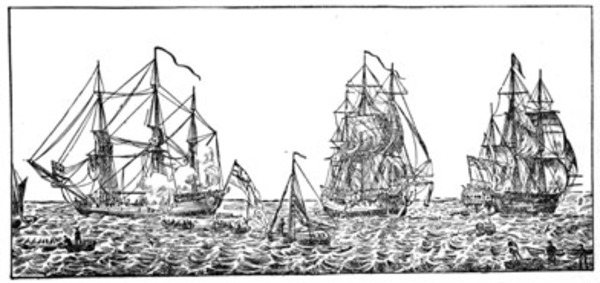
Source: Link
FLETCHER, JOHN, British naval captain; d. 1697.
Fletcher, who was twice taken by the enemy during the war of the League of Augsburg (1688–97), became captain of the fireship Terrible (238 tons) in 1694, and in January 1695 sailed with the fleet to the West Indies. He became commander of H.M. frigate Hampshire (479 tons) in May 1695 and remained on duty at Jamaica after the fleet returned to England in the following August. He was recalled the next year and reached the Thames in January 1697.
In accordance with Admiralty orders Fletcher, in the summer of 1697, undertook the task of convoying the HBC’s ships Royal Hudson’s Bay (Capt. Nicholas Smithsend) and Dering (Capt. Michael Grimington*) to York Fort which, in the previous year, the last-named captains had helped to recapture from the French. The fireship Owner’s Love (Capt. Lloyd) which also joined the expedition was crushed by ice, but Fletcher and the Company’s captains, after unsuccessfully attacking the French ship Le Profond, commanded by Pierre Dugué* de Boisbriand, in Hudson Strait, continued their voyage. When off Port Nelson on 26 August (o.s.) they encountered and attacked Pierre Le Moyne* d’Iberville in his flagship Le Pélican. In an engagement lasting several hours both it and the Hampshire were damaged. Iberville claimed that a broadside from Le Pélican was responsible for the sudden sinking of the Hampshire and the loss of Fletcher and his crew, but it is doubtful if guns of that period could have instantaneously sunk so large a ship. An English account of the action mentions a French tribute to Fletcher’s bravery and expresses doubt as to whether battle damage or “a fflaw of Wind” caused the Hampshire to sink. This account supported Mary Fletcher’s successful petition to the king for a pension as compensation for the death of her husband.
The loss of the Royal Hudson’s Bay and the surrender of York Fort [called Bourbon by the French] by Governor Henry Baley* swiftly followed Fletcher’s disaster and so began the French occupation of the Hayes River area which was to continue until ended by the Treaty of Utrecht (1713).
Information on Fletcher will be found in PRO, Adm. 51/4367, 4212; Adm. 6/4, f.64; Adm. 8/3; CSP, Col., 1693–96. PAC Report, 1934, 6–9. [Nicolas Jérémie], Twenty years of York Factory 1694–1714: Jérémie’s account of Hudson Strait and Bay, tr. from the French ed. of 1720 with notes and intro. by R. Douglas and J. N. Wallace (Ottawa, 1926), 28–30. N. M. Crouse, Lemoyne d’Iberville: soldier of New France (Ithaca, 1954), 139–54 (it should be noted that the Captain Smithsend referred to is Nicholas rather than Richard). For another account of the sinking of the Hampshire see Guy Frégault, Iberville le conquérant (Montréal, 1944).
Cite This Article
Alice M. Johnson, “FLETCHER, JOHN (d. 1697),” in Dictionary of Canadian Biography, vol. 1, University of Toronto/Université Laval, 2003–, accessed December 22, 2025, https://www.biographi.ca/en/bio/fletcher_john_1697_1E.html.
The citation above shows the format for footnotes and endnotes according to the Chicago manual of style (16th edition). Information to be used in other citation formats:
| Permalink: | https://www.biographi.ca/en/bio/fletcher_john_1697_1E.html |
| Author of Article: | Alice M. Johnson |
| Title of Article: | FLETCHER, JOHN (d. 1697) |
| Publication Name: | Dictionary of Canadian Biography, vol. 1 |
| Publisher: | University of Toronto/Université Laval |
| Year of publication: | 1966 |
| Year of revision: | 1979 |
| Access Date: | December 22, 2025 |



